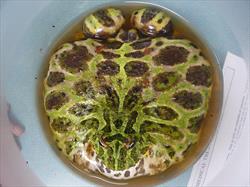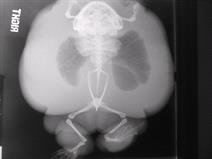
This 23-year old ornate horned frog, sitting in a bowl, has the fluid accumulation (edema) that is often seen with septicemia. Photo by Dr. Yoko Tamura.
Septicemia is an overwhelming infection throughout the body (systemic) by one or more species or types of bacteria. Common bacteria that cause septicemia in amphibians are Aeromonas and Flavobacterium, but many species can cause this condition.
The first signs that owners often notice about amphibians with septicemia is lethargy or anorexia (lack of appetite). These general signs mean the amphibian is just not feeling well. Other common signs are a red to pink skin color on pale areas of the body, especially the chin, throat, gills, ventral skin, thighs and webs of the feet and toes; swelling of the whole body or fluid accumulation under the skin, making them look bloated; a weird but not uncommon sign is when the amphibian’s stomach comes out of the mouth (it can go back in and the amphibian will be fine); twitching of the limbs or toes, convulsions, paralysis and sudden death also occur in amphibians with septicemia.
How do these bacteria infect an amphibian? Most commonly, bacteria are able to invade the body through a break in the skin, such as an abrasion that removes the antimicrobial mucous layer on the skin; or through failure of the immune system, often as the result of chronic stress caused by poor husbandry. A diet low in vitamin A is implicated as one of the leading causes of immunosuppression in captive amphibians.
The bacteria causing the septicemia may be from a single type of bacteria or multiple species.
Affected Species
All species, ages and stages (tadpoles) of amphibians are susceptible to developing septicemia.
Diagnosis

This x-ray of the same ornate horned frog, taken at the same appointment, shows how swollen she is compared to her bones. Photo by Dr. Yoko Tamura.
There are a multitude of disease and conditions that can look like septicemia, so it is important that you take any ill amphibian to your veterinarian quickly. Owners of ill amphibians should call their veterinarian before coming into the office for the appointment because oftentimes your veterinarian will ask you to take some measurements of the water or collect substrate samples for analysis. These measurements include the temperature of the water, the pH, and the total ammonia nitrogen (TAN). All of these measurements must be taken directly from the tank and can be obtained using an ammonia and pH test kit designed for freshwater tropical fish tanks. Test kits are available at pet supply stores. If this is not possible, then an airtight glass jar filled to the top with the aquarium water should be brought into the veterinary office and analyzed as soon as possible.
Your veterinarian will start by taking a thorough medical and husbandry history and give your amphibian a physical examination. In many cases, the exam findings suggest septicemia as the cause, to confirm the suspicion and determine the type of bacteria the amphibian has, your veterinarian may want to collect blood or take some of the fluid from the stomach for evaluation and culture from an outside laboratory. In the clinic, your veterinarian will likely want to perform a skin scrape (using a slide to collect some surface material) and look at it under the microscope to try to identify the bacteria. In some cases, a biopsy of a skin wound will be taken and sent to a laboratory for examination and culture.
Treatment
The goals of treatment are to eliminate primary infection (the single or multiple bacterial species detected as cause), treat any secondary organisms, maintain or correct hydration and electrolytes (using IV fluids given by injection or as a bath that the amphibian sits in) and to prevent the spread of infection to other amphibians in the collection.
If the species of bacteria was able to be identified, and a sensitivity test that tells you which antibiotic will kill this bacteria was done, then your veterinarian can prescribe the correct antibiotic to use. Often the exact bacteria are not able to be identified and your veterinarian will prescribe one or commonly two types of antibiotics based on experience and the common bacteria that cause septicemia. Common types of antibiotics you might hear your veterinarian talk about include: enrofloxacin and ampicillin; amikacin and ampicillin; amikacin and ceftazidime; amikacin; amikacin and metronidazole.
Correcting any husbandry deficiencies is critical for treatment to be effective. Your veterinarian may suggest that you consider stripping the cage bare, disinfecting it, and starting over from scratch with new substrate and furnishings.
Few amphibians survive once clinical signs of septicemia are seen., so oftentimes treatment is aimed at preventing outbreaks in unaffected cage mates or the rest of the collection.
Prevention
Some of the most effective keys to preventing septicemia are appropriate quarantine practices: never put a newly acquired amphibian into a cage with another one already in the collection. Discuss with your veterinarian the proper way to perform quarantine and how much time is needed.
Review specific husbandry needs for the species you have. It’s really important to talk to your veterinarian about husbandry, your current feeding practices, and handling of vitamin mixes. Proper husbandry and diet with appropriate levels of vitamin A are necessary. One common problem is the use of degraded vitamin products that have been exposed to heat and high humidity, or a vitamin product that uses beta-carotene as its source of vitamin A. Appropriate water quality and stocking densities are key aspects of prevention. Discuss the proper filtration to use for your particular set up and which types of water testing kits with which to monitor your water quality.
Ensure that crowding and aggression between tank mates are not contributing to the problem.
Prognosis
The prognosis for amphibians with septicemia varies by how long they have had the disease and what types of bacteria are causing the problem. There is generally a poor prognosis for amphibians that have signs more extensive than mild redness of the skin. There is, however, a better prognosis for amphibians that are still eating and have only mild redness. A key to success is to get your ill amphibian to your veterinarian as soon as you notice any sign of illness.